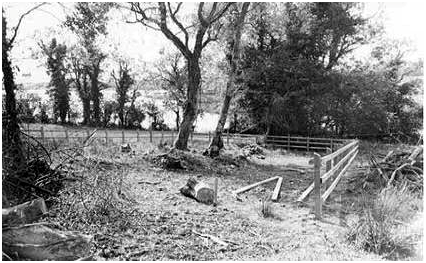|
CHAPTER TWO
ORIGINS
There are
several accounts about the origins of the Tinneny
family, from where they came and how they came to settle
at Goladuff in County Fermanagh, Ireland. These have
been passed down through both family and local tradition
in Ireland.
Mary Tinneny
O'Kane remembered her grandfather Tommy, who was born in
Belturbet, County Cavan, Ireland in 1856, telling her
many times that the family came to Ireland with the
Vikings during the Norman invasions. He attributed the
woodworking occupations of generations of Tinnenys to
his ship building Viking ancestors. Likewise, he
attributed the red hair, which tends to be quite
prominent in the family to this heritage.
Then there
is the Spanish connection. James J. Tinneny Jr., the
grandson of
Yankee Pat and great-grandson of Big John Tinneny of
Goladuff, recalled his father telling him that the
family had left Ireland during the time of Cromwel's
persecutions and that they went to Spain. In Spain they
settled near a Catholic seminary in the town of
Salamanca. The seminary trained Irish men for the
priesthood and following their ordination they returned
to Ireland to minister to the people. James told his son
that at some point the Tinnenys returned to Ireland but
he did not know when. James Jr. thought he was told that
the family lived in Armagh when they returned, however,
I've found no evidence of this. Armagh is located about
30 miles from Goladuff.
From the
other side of the Atlantic Ocean in a conversation with
a Kim Tinneny, who said she was the wife of Robert
Tinneny living in London, I was surprised to learn of
another reference to a Spanish connection. In response
to my inquiry, as to where Robert's family came from, I
was told that they were believed to have originally come
from Spain. She had no further details on this Spanish
connection.
She did know
that Robert's family had immigrated to England from
Belturbet in the early 1900s. The fact that stories of
Spain in our background have come down through 3 or 4
generations of Tinnenys on different continents, who did
not know of each other and whose branches of the family
had not been in contact for over a hundred years, adds
credence to the idea that there may very well have been
a Spanish connection of some sort in our past.
Both family and
local tradition in Counties Cavan and Fermanagh in
Ireland indicate that the first Tinneny settled at
Goladuff about 1689. It is believed that he and a
comrade-in-arms named Tummin were soldiers in the army
of General Justin McCarthy, which was part of the army
of the ousted Catholic King James II of England.
Following is
an account by an unknown author that describes the
engagement. In the winter of 1689 the army of James II,
including McCarthy's unit marched north through Ireland
and saw much action against the Protestant army of
William of Orange in southern County Fermanagh.
McCarthy's plan was to capture Crom Castle, which was an
outpost for the town of Enniskellen located along the
upper part of Upper Lough Erne. The first attempt of
McCarthy's Army to take the Castle in July was repelled
by the troops of Colonel Berry. A second encounter
between the two forces took place, the same day near the
town of Lisnaskea, which is also in County Fermanagh.
The second encounter ended in the failure of McCarthy's
forces to meet their objective.

One section
of the army marched down the Derryvona Road. They
crossed the River Erne at a narrow pass at Inishfendra
and were advancing toward Crom Castle. They had used
boats, called cots, which they tied together with gads
(the Gaelic word gad means a rope or tying) to form a
pontoon bridge to facilitate crossing the river. On
their return from the battle they found that the gads
had been cut and the cots had drifted down the river.
Thus, their retreat was blocked and the Williamite
Enniskilleners were in hot pursuit. No mercy was shown
as this faction of McCarthy's army was slaughtered. They
had been backed up to the river with no place to escape.
Since that time the place has been known as the "Bloody
Pass." It was from this battle of the Bloody Pass that a
Tinneny and a Tummin were said to have swam off and
escaped and found their way to the small island like
peninsula of Goladuff which is not far from the Bloody
Pass.
Photo:
Cleared and fenced Cuilleann (Holly) Burial Ground.
Courtesy of Fidelma Tinneny Tanner
A mass grave
was dug on the bank of the River Erne at the Bloody Pass
and as many as 500 men are believed to be buried there.
This burial ground of the slaughtered section of
McCarthy's army is known as Cuilleann (Holly) Burial
Ground.
In April
1987, while she was a student at Saint Bricin's
Vocational School in Belturbet, Fidelma Tinneny, the
daughter of Hubert and great-great-granddaughter of "Big
John" Tinneny, headed up a project with her classmates
which researched, cleared and fenced the long overgrown
burial site of the Irish patriots slaughtered at the
Battle of the Bloody Pass.
A different
account of how the Tinnenys came to Goladuff was
provided in 1992 by Mr. Francis Fitzpatrick "Francie of
the Key" of Derrydoon near Goladuff. Francie was a local
historian. He said, that as a young boy he remembered
an old man by the name of McElgunn telling him that the
Tinnenys had been relocated to Goladuff several hundred
years before from the town of Urney. Urney is located
near Belturbet, County Cavan, which is across the Quivvy
Lough from Goladuff. At the time it was quite common for
the British landlord in the area, who had an estate
covering 40,000 acres, to move his tenants around at
will.
  |